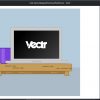When creating a captivating web design you also need to look at the big picture. Your site’s performance in search engines is critical to gaining healthy amounts of traffic. Search engine optimization is considered mainly a tech job that has little to do with design. Turns out, if you want to launch an SEO optimized website you need to take a closer look at how your web design is laid out and performed.
Responsive Design
Having a static design that fits only one specific screen size is a thing of the past. Nowadays, responsive web design is one of the most crucial factors that determine the performance of your website in search engines. If you want to be on top of the trend wave and keep your visitors happy you need to make sure your site looks great on any device.
Image Optimization
Large, high-definition photography might look like an eye-catching addition to your designs but you should think twice before uploading a 5MB image on your website. There are a couple of reasons why you shouldn’t overlook the size of your images.
Limited Bandwith
First of all, if your website has limited bandwidth you face the threat of exceeding those limits and thus, getting your website down. Although you can, of course, pay your hosting company for bandwidth extension, the temporary malfunction of your website will be well noted by search engines. When your website is not reliable 24/7 without excuses then it will imminently drop in the search engine results page.
Slow Image Loading
But let’s consider limited bandwidth is a thing of the past and may not apply to your site. You still need to make sure your images aren’t too difficult for the server to load. Slow loading of images will not only piss off your visitors but it will let web crawlers know your website provides poor user experience. This will lead to rankings drop in the long run.
For best results: Optimize your images to about 72dpi each and make sure they don’t exceed 200kb.
Video Optimization
Embedding a video or hosting it on your own website are great ways to spruce up your content. Having a wide variety of content types ( images, videos, lists, etc ) is actually favored by search engines. Yet, the lack of video optimization can play a bad trick on you. Here’s why.
Just like images, videos need to have detailed descriptions in order to be crawlable by search engines. This means your file name, alt title and description need to be filled with relevant information about the particular video. Also, while images might sometimes be correctly “understood” by web crawlers, the case is not the same with other media files. This is why transcribing each video is essential. Otherwise, search engines might not have a clue about what exactly is this video about.
Flash Design
Believe it or not, web crawlers find it hard to read flash. There are tricks to make your flash site somewhat readable but in general, having a website run fully on flash is considered a bad idea when it comes to search engine optimization. This means having a cool flash menu is also out of the question. Flash should be used only on design elements that are not crucial to your site’s on-page SEO.
Splash Page
The home page is one of the most important pages of your website that determines your site’s performance in search engines. The content, keywords, and links on your homepage are a guiding light not only for your visitors but also for crawlers. Having a static splash page with your logo and a link to your website might look like a clean and minimalistic design choice but in fact, it’s one that can hinder your site’s rankings. It will not only make some users bounce off your site but it could also lower the link juice your site gets.
Code Optimization
The code-to-text ratio of your website plays an important role for your site’s SEO performance. Having too much unnecessary code on your website might decrease your chances of ranking higher. Yet, this doesn’t mean you should go and replace your code-based elements with images. A rule of thumb for high readability by web crawlers is using HTML, CSS, and web fonts whenever possible. This includes banners, menu text, even text-based logos, and anything that can be easily created with HTML and CSS. When provided as HTML, the text is readable by search engines.
Social Sharing Buttons
You might think that placing social sharing buttons has nothing to do with your site’s performance in search engines but good SEO practices can prove you wrong. Social buttons make it easier for your visitors to share your content and let crawlers know your online presence isn’t limited to your own website. Having well-maintained social profiles and high engagement in social media will help your site’s performance. Yet, this doesn’t mean you should spam your followers and post every hour. Consistency and value are the keys to producing great content.
Breadcrumbs
They may look like something you could easily skip, especially when going for a minimalist design. Yet, breadcrumbs are an extremely important element that shouldn’t be overlooked. They let your visitors know where they are on your website which has a high UX value. And, of course, search engines are all about providing great user experience.
